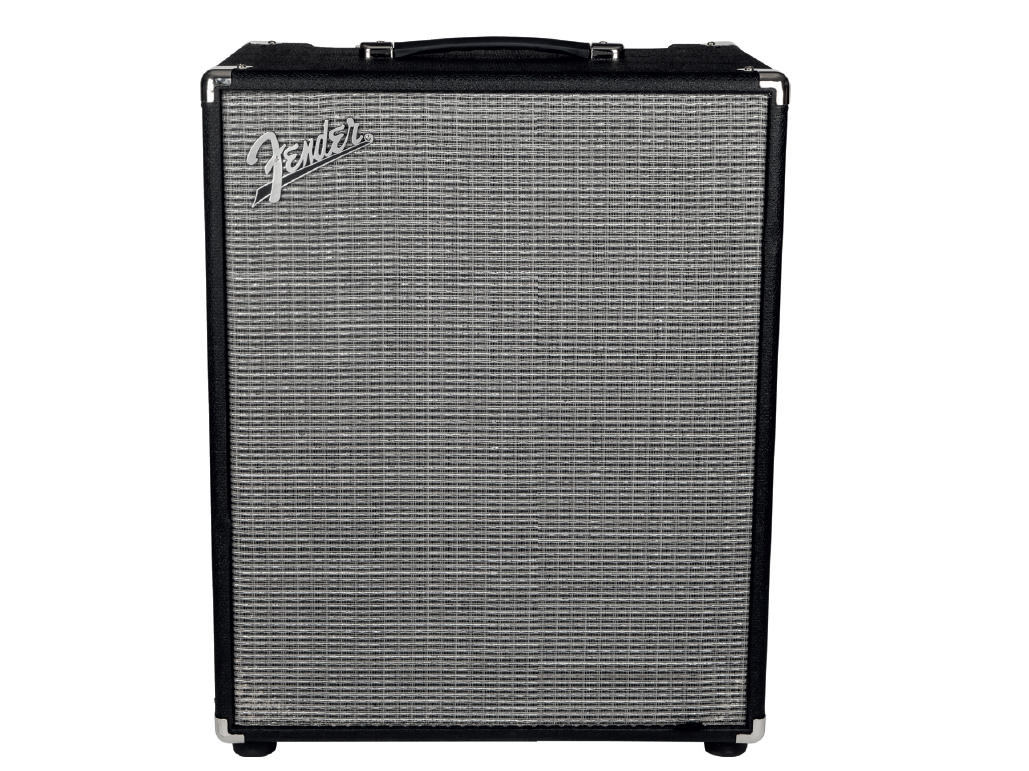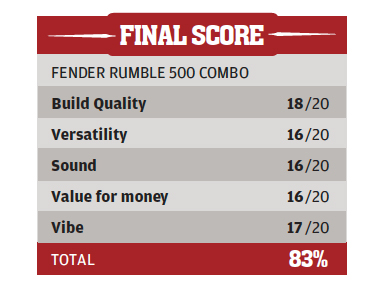Related Tags
Fender Rumble 500 Combo Review
Now lighter and louder with upgraded speakers, we see how the mightiest combo in Fender’s Rumble series shapes up. Review by Gareth Morgan.

Description: Single-channel 500W Class D combo with two 10″ Eminence speakers and a ceramic tweeter in a 16mm plywood cabinet with front porting. Made in Indonesia
RRP: £598.80
Range options: Rumble 15, £130.80; Rumble 25, £190.80; Rumble 40, £238.80; Rumble 100, £298.80; Rumble 200, £498.80; Rumble 200 head, £298.80; Rumble 500 head, £490.80. Rumble 115 1×15″ cabinet, £358.80; Rumble 410 4×10″ cabinet, £490.80
Contact: Fender GB&I – 01342 331 700 – www.fender.com
With a good choice of models from weeny solid state practice combos up to formidable 500W Class D combos and separates that’ll take on a frenetic pub gig unaided, the new Indonesian-made Fender Rumble bass amps are trying hard to impress. This month we’re looking at the most powerful combo, the Rumble 500.
It’s easy for Fender to draw upon just about any period from its history to achieve instant retrofication, and with the Rumbles they’ve plumped for black vinyl and a silver grille cloth combined with cream knobs and an old-school logo from the blonde amp era.
The looks get a big thumbs-up from us, but despite the weight-saving of the Class D power unit, the plywood cabinet and the two ceramic-magnet Eminence speakers add up to an all-up weight of 16.56kg/36.5lbs, so that single top-mounted carry strap doesn’t really feel like enough. Corner protection is via steel caps, rubber feet cushion the bottom, and beneath the grille and alongside the speakers there’s compression tweeter (with an on/off switch around the back) and twin circular ports.
The control panel has eight retro knobs – Gain and Master at the extremities, with an overdrive section on the left featuring Drive (distortion intensity) Level (of distortion signal) and on/off button. This is remotely footswitchable, but mean ol’ Fender makes us pay extra for one of those.
Between Gain and Drive are three preset button-activated EQ shapes: Bright (adds ‘presence and shimmer’ at the top end via +13dB@10kHz), Contour (scooped mids, or -13dB@670Hz, +1dB@80Hz, +2dB@8kHz) and Vintage (which squashes your tone and darkens the midrange via up to -9dB dynamic compression with low pass). There’s also a simple four-band EQ numbering Bass (+/-15dB@80Hz), Low-Mid (+/-12dB@280Hz), High-Mid (+/-12dB@1.2kHz) and Treble (+/-15dB@10kHz). On the back you’ll find jack sockets for extension speaker, FX loop, Aux In, phones and the footswitch plus an XLR DI Out with Ground/Lift switch.
Sounds
First, those pre-shapes: Vintage feels a bit too squashed, Contour is rather glassy, and Bright is noticeably modern in tone. Switch those off, and the Rumble 500 has a tight, natural-sounding bottom end with pleasing snarl. The midrange is even and clear-speaking, and with the horn disengaged the highs are clean with plenty of body and a decent snap.
Enabling the tweeter predictably adds slashing cut and bite and wakes up the harmonics, but there’s a price to pay in terms of finger-noise and loss of warmth. No tweeter level control is an issue so we turned it off again, and that’s no problem as the regular EQ’s treble control gives you quite enough lively-sounding cut.
Rockers will like the effect of adding bass EQ, fattening and softening low notes while retaining a substantial residue of definition. Interestingly, the tone seems to compress just a little as you load on more dB’s in an almost valve-amp style. The onboard distortion is acceptable, with varied mayhem of reasonable quality from the Drive knob, with an interesting gnarly, crunching variation with this control minimised.
Verdict
Bear in mind that you’ll only actually get 500W out of the R500 hooked up to an extension cab, but 350W is still not a bad return for just under £600. Tonally the Rumble 500 has some good stuff on offer: solid-sounding bass, an even midrange with options to morph as you see fit, and highs, without the horn, that are natural and practical, with more on offer via the pre-shape buttons.
We’d like to see side handles, but this is still perhaps the most sensibly portable combo series this company has made, and they look and feel like Fender amps; classy, cool, and easy to live with.

